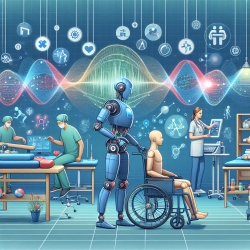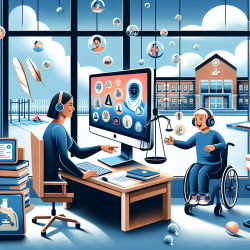Introduction
In the rapidly evolving field of rehabilitation robotics, understanding the latest trends and research hotspots is crucial for practitioners aiming to enhance their therapeutic skills and outcomes. The bibliometric analysis titled "Global Trends and Hotspots in Research on Rehabilitation Robots: A Bibliometric Analysis From 2010 to 2020" provides valuable insights into the trajectory of this innovative field. As a practitioner, integrating these insights can significantly improve the effectiveness of your interventions, particularly in pediatric settings.
Key Findings from the Research
The study highlights several key trends and hotspots in rehabilitation robotics:
- Brain-Computer Interfaces (BCI): These interfaces are gaining traction for their potential to restore motor functions in patients with neurological impairments.
- Virtual Reality (VR): VR is being increasingly used to create immersive rehabilitation environments that enhance patient engagement and outcomes.
- Flexible Wearables: Wearable technology is becoming more prevalent, offering personalized and adaptable rehabilitation solutions.
- Exoskeletons: These devices are crucial for assisting mobility and promoting independence in patients with mobility impairments.
Implications for Practitioners
For practitioners, these trends suggest several actionable strategies:
- Incorporate Technology: Integrate BCIs and VR into your practice to offer cutting-edge therapeutic options that enhance patient engagement and outcomes.
- Adopt Wearable Solutions: Utilize flexible wearables to provide continuous monitoring and personalized feedback, which can be particularly beneficial in pediatric therapy.
- Focus on Multidisciplinary Collaboration: Engage with professionals from engineering, neuroscience, and rehabilitation to develop comprehensive treatment plans that leverage the latest technological advancements.
Encouraging Further Research
The study underscores the importance of continued research in rehabilitation robotics. As a practitioner, staying informed about emerging technologies and their applications can help you remain at the forefront of the field. Consider collaborating with research institutions to contribute to the development of innovative therapeutic solutions.
Conclusion
Rehabilitation robots represent a promising frontier in therapeutic interventions. By understanding and applying the insights from the latest research, practitioners can enhance their practice and improve outcomes for their patients, particularly in pediatric settings. To explore the detailed findings and data, you can access the original research paper Global Trends and Hotspots in Research on Rehabilitation Robots: A Bibliometric Analysis From 2010 to 2020.










